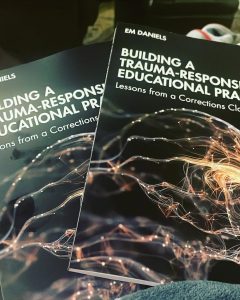A (very) brief overview
I’m sharing this information because prison education programs (PEP) are almost entirely overlooked in terms of professional development. Prison ed programs are often isolated, very small, and there is little material or training specific to their unique circumstances. That’s why I wrote my book, and am glad to see that the field is now growing rapidly.
If you are part of a Teaching & Learning Center, or other professional development arm of your organization and have a prison education program on or affiliated with your campus, I encourage you to reach out to them. If they work in a facility full-time, their scheduling needs are likely to clash with regular campus hours and offerings. They may also be interested in offerings tailored to their particular environment and population.
Prison education programs have existed mostly on the fringes between community colleges, universities, and volunteer programs. Until 1994, Pell was available for prison education, but the 1994 Crime bill banned Pell for incarcerated people. That changed in December 2020, when Congress lifted the ban and reinstated Pell, beginning July 1 2023. As you can guess, it has been a big lift for existing programs to prepare, and the number of new programs trying to get up and running is overwhelming.
Most carceral (prison & jail) education programs are isolated from their free campus counterparts, especially if they are fully formed programs that operate in a prison facility. Many programs are a combination of a few faculty who teach part-time at the prison or jail, and work with college and Department of Corrections (DOC) or jail staff to handle administrative tasks. Programs that are fully located inside of facilities operate almost like their own campus, handle their own admissions, enrollment, financials, and other student-related activities.
Resources for prison education programs have been few and far between for the last three decades, but that is changing also. In the last three years, there has been a great deal of work at the national level to help people understand the impacts of Pell reinstatement, and how to plan and build programs. This planning and development is complex and requires attention. Prison ed programs may operate like their own mini-campus, handling both instruction and student services. They must navigate the needs of students, requirements of college systems, and the demands of DOCs and other carceral facilities.
NOTE: At this time, I am not aware of any college or other institution offering credit or non-credit coursework specific to teaching in prison. There are efforts underway to create such training to onramp new instructors, and ongoing training for more experienced professional.
I’m happy to answer questions or make connections, and also recommend my book, Building a Trauma-Responsive Educational Practice: Lessons from a Corrections Classroom.(Routledge, 2022)

More Information
Alliance for Higher Ed in Prison
- https://www.higheredinprison.org/
- https://www.higheredinprison.org/national-conference (2023 conference information)
Corrections Education Association
- https://ceanational.org/
- https://ceanational.org/conferences/ (2023 conference information)
Pell reinstatement
- https://nationalreentryresourcecenter.org/events/countdown-pell-reinstatement-getting-ready-pell-reinstatement-2023
- https://www.vera.org/publications/accessing-pell-grants-for-college-programs-in-correctional-settings
- https://www.vera.org/downloads/publications/restoring-access-to-pell-grants-for-incarcerated-students.pdf
- https://www.vera.org/research/preparing-for-pell-reinstatement
Most of all, let your folks know that you’re thinking about them and care about their development as educators. In my experience, many prison eductors rarely engage with their TLC or prof dev folks. They may not even know they are a resource. I would love for that to change, and for prison ed folks to feel more connected to their free campus colleagues.